Pekka Halonen was a painter of Finnish landscapes and people who would go on to become one of the more notable painters in the world of Finnish Art. This Post provides what’s probably the most detailed information you’ll find on Pekka Halonen in English (there’s not much….) as well as a fairly detailed description of his old house, Halosenniemi (which is now a museum dedicated to his work) and his lifestyle. Following all of that, there’s a collection of images of his paintings, from which you can well see why he’s regarded as one of the great painters of the Finnish “National Romatic” era. Hope you enjoy, and if you do go to Finland, Halosenniemi is well worth a visit (and not to far from Helsinki).
Pekka Halonen was born in Linnasalmi, Lapinlahti, Finland on 23 September 1865, the son of Olli Halonen, a peasant farmer and artisan, and Wilhelmiina Halonen (née Uotinen). His mother, Miina, was an accomplished folk musician. The family consisted of five sons and two daughters, with Pekka the third oldest of the seven children. In 1885 he tried for a place as a Primary School Teacher, but his score was not good enough to gain entry into teacher training. He moved to Helsinki where his only acquaintance was the architect, Josef Stenbäckin. He announced to Stenbäckin his intention to become an artist and in Autumn he began art studies. To finance himself, he worked in construction and as a decorative painter when jobs were available. In the Spring of 1866 he was elected to study at the Ateneumiin, the Finnish Art Society’s Drawing School.
In the spring of 1867 Halonen received, along with three other students, the school’s silver pen prize for progress and diligence. That summer Halonen worked hard, but earnings were, however, so poor that he had to resort to asking his municipality of residence for assistance so as to be able to continue his studies at the Athenaeum. He had to write his application in Swedish, “because Finnish does not qualify for any assistance”. He studied at the Ateneumiin from 1866 to 1890, with his teachers being Carl Jahn and Fredrik Ahlstedt. Fellow students included Albert Gebhard, Ellen Thesleff and Väinö Blomstedt. He received excellent grades, and a stipend of 200 marks. Halonen spent the summer of 1890 at home in Lapland on the Gulf and painted, among other things, the work Honkaniemi . He studied French and took private lessons to assist in learning French more proficiently, in 1890 in Paris, first at the Academie Julian and later under Paul Gauguin.
Halonen lived with his family in a house and studio on Lake Tuusula in Tuusula, Finland, that he himself designed and named Halosenniemi. The building is now a museum that includes original furnishings and Halonen’s own art. On the shores of the lake where he resided an artists’ community flourished, helping to develop a sense of Finnish national identity. Halosenniemi was designed with the two-storey studios of Paris in mind, with high ceilings and tall windows in the studio, and second-floor living-quarters accessible by a set of stairs and a balcony that overlooked the studio. Adjacent to the house Halonen built a sauna, which in typical Finnish tradition also served as a laundry. Halonen stated that he never painted for anyone but himself. He felt that “Art should not jar the nerves like sandpaper – it should produce a feeling of peace.”
Halonen died in Tuusula on 1 December 1933.
Halosenniemi – The Home of Pekka Halonen in Tuusula, Finland
Halonen moved to the serene and peaceful environs of Tuusula in 1898. He had often visited Lake Tuusula for combined skiing and painting trips and on one of his trips he fell in love with a narrow and rocky site that he declared to be the perfect spot for his own “little cabin”. After lengthy negotiations he bought the land from a local farmer, Johan Robert Alenilta, in May 1899. That place would become the site of the imposing pinewood villa known as “Halosenniemi”, a beautiful building that he and his brother Antti Halonen designed. Initial delays in construction and slow progress were due to a lack of money. However, construction got going in the spring of 1901 and continued over two summers and one winter. Halonen oversaw work down to the smallest details. He monitored the manufacturing of bricks and tiles, as well as masonry work and the design of the heating system. The logs used in construction were cut in mid-winter and carefully and aesthetically trimmed and carved.
The studio location affected the entire design and was the heart of the house as well as Pekka Halonen’s office and working space. The room was located where natural lighting would be at its best and was two stories in height, facing north. It was also the most difficult area of the house to heat and this was a concern that Halonen wanted to solve – he apparently had bad memories of the discomfort of living in a cold dwelling from the harsh winter season of 1899-1900. The heating system he had installed was a hot air system based on furnaces. The large window of the studio used triple-glazing with other windows throughout the house using double glazing. In addition, every room had some source of heat – an oven or stove or fireplace. Each of these was designed individually. Adjacent to the house, Halonen built a sauna and, in typical Finnish tradition, the sauna also served as a laundry.
“Halosenniemi” and was completed in 1902 and was where Halonen lived with his family and worked in his studio. The beautiful and serene building is now the Halosenniemi Museum and includes both the original furnishings and a collection of Halonen’s own art on the walls. There, on the shores of Lake Tuusula where Pekka Halonen resided, an artists’ community developed and flourished, helping to develop a sense of Finnish national identity.
The architecture of Halosenniemi should be seen as an expression of the cultural aspirations of the Finnish “National Romantic” era. Over the years, Halonen had developed a clear picture in his mind of the house he wanted. The concept had started in Paris in 1892 where Halonen and his friends,Emil Wikström and Axel Gallen-Kalela had drafted a design for an ideal Finnish home based on the traditional Finnish crofters cottage. In the early 1890’s, many Finnish artists built studio-villas in rural areas which they used year-round. Their aim was to build a distinctive “Finnish” style of home by integrating local architecture together with elements borrowed from various other cultures and architectural styles. In design these villas, the artists adapted the layout of the two-story studios they had seen in Paris: high ceilings and large windows with stairs leading up to first-floor living quarters via an indoor balcony that overlooked the studio. In journals such as “The Studio”, Finnish artists studied pictures of English country homes with open fireplaces (amongst other influences). Finnish artists also borrowed a mixture of influences from Norwegian, Swedish, Swiss and Russian architecture, which they incorporated together with elements adapted from the design of Karelian log houses and other local Finnish architectural styles.
In the autumn of 1894, Halonen had also visited Visavuori and this heavily influenced his own later house design. The house designs of Axel Gallen-Kalela, Emil Wikström and Pekka Halonen reached a distinctive solution by investing in a home and studio space under the same roof. They wanted to use their houses to express their view of art in addition to their own values and worldview. These artists homes differed significantly from both the older and the then-current wood and villa architecture in Finland. Their design utilized vernacular buildings in an original manner, but their are also very visible foreign influences.
Halosenniemi as a Museum dedicated to Pekka Halonen
Tuusula municipality bought Halosenniemi in 1949, although Halonen’s children retained the right to use some of the space in their own lifetimes. Halonen’s studio was opened to the public in the 1950’s. Antti Halonen was a familiar sight in Halosenniemi, he lived on the building during the summer months and also worked actively on the Halosenniemi nature conservation area. In those early decades, the Halosenniemi building served as the Tuusula local history museum and part of the family home was lived in by a caretaker. In the 1970’s the decision was made to returned Pekka Halonen’s home into an art museum dedicated to the artist’s works. The caretaker’s family lived in Halosenniemi into the 1980’s but towards the end of the decade, the decision was made to return the whole of the building to its original state as Pekka and Maija Halonen’s home.
Restoration work began in the late 1980’s, returning the building to its original state and removing later additions and changes. The interior was also returned to its original state, Halosenniemi’s old furniture was purchased back, and some pieces were commissioned from old designs and photos. In its current form, Halosenniemi opened to the public in 1990. Today the museum specialises in presenting material related to Halonen’s art, his lifetime achievements and the famous artists’ colony of Tuusula to which he and his friends belonged. Every year the museum hosts 4-5 theme exhibitions showcasing Halonen’s art side by side with the work of his contemporaries and later generations of artists up to the present day.
The Musuem is open from May 1st to August 31st Tuesday-Sunday 11am-60pm From September 1 to April 30 the Musuem is open Tuesday-Sunday 12am-5pm. Upi should also check the Museum schedule as they close for some public holidays. Admission is 6€ for Adults, 2€ for Children 12-18 years and if required, Guidance Fee is 30€ (Guided tours need to be pre-ordered). Note that War Veterans and Children 11 and under are free. Please see here for a Map of Halosenniemi’s location.
The Restoration of Maija and Pekka Halonen’s garden
By 1990, the Halosenniemi old garden had gotten badly overgrown and had was a good way along to expiring. Ornamental Plants repressedrose so high in summer that only the apple trees were clearly visible. Ornamental shrubs persevered among the roses which had grown over and around them while fast-growing aspens had also spread into the garden from each side. Later in the 1990’s, restoration of Pekka and Maija Halonen’s garden was completed and it was opened to the public in 2000. A sandy path circulates around the garden and along this path informational signs can be found, where the history of the garden is documented.
The restored garden is based on the the work of landscape architect Gretel Hemgård and documented in the Operation and Maintenance Plan (1990). The aim was to restore Halosenniemi’s surroundings in such a way that it honored and admired Pekka Halonen. The restoration design was based on much original material. Pekka Halonen’s paintings as well as original manuscript interview material, old photographs, letters, and other works of art.
Pekka Halonen made a series of paintings of the plants and of views of his garden. In fact, during rehabilitation of the garden, dozens of old ornamental plantswere discovered as the ground was broken for planting – and temporarily lost plant seeds started to sprout again. Under the soil was also found two brick paths which the family used, with bricks made by Pekka Halonen and Juhani Aho. The original flower beds have also been dug up from under the ground. A wide range of vegetables and root vegetables, which Maija Halonen began to cultivate in 1900, are also found; among them brussel sprouts, broccoli, cauliflower, red cabbage, cabbage and pointed cabbage. Frames to grow tomatoes and pickling cucumbers are also found in the garden.
Living in Halosenniemi
Living in Halosenniemi in his comfortable but simplistically furnished home, Pekka Halonen was able to both focus on his nature painting and to enjoy family life. Little by little, they purchased new furniture or picked up pieces at auctions. Their home became a very popular meeting point for friends with its simple essence and warm spirit creating a cozy atmosphere. Frequently Halonen’s friends organized evening events – serious discussions interspersed with fun. Home concerts and sauna evenings gradually became a Halosenniemi tradition.
The family’s food economy was strongly attached to the seasons of the year and was very self-sustaining. Only essential foods were purchased from the nearby village shop or from neighbors. Root vegetables, vegetables, spices and herbs were grown in the home garden, fish was caught in Lake Tuusula, berries and mushrooms were gather in the nearby forests. Weekdays at the dinner table reflected Halonen’s modest and simple lifestyle, and there were plenty of vegetables and salads in both summer and winter. Weekday menus usually were made up from potatoes, gravy, soups, herring, macaroni and fish. Pea soup and pancakes was the usual dinner on Thursdays. Maija’s specialty was baked pastries, inside which were cauliflower and beans. Public holidays always saw “better” food – roast beef, which was placed in the center of the table on a serving tray along with carrots and cauliflower with a border of boiled rice. Their would also be chicken, veal or lamb on occasion, One of Pekka’s favorite delicacies was savo rye bread, which Maija had learned to bake.
Pekka Halonen spent most of his days painting. He never compromised at all on his requirement for authenticity. He would depart for his painting trips regardless of the weather and even in extremely cold weather. Halonen painted persistently even when the temperature was more than 30 degrees below zero. At this degree of cold, the oils he used for painting were unusable and the color was then applied using the fingers and a palette knife. When painting outdoors, Halonen often lingered well into the evening or dusk. Maija often wondered, how he could return intact and uninjured in the dark. Often, after returning home, Halonen continued to work on completing his paintings from photos. As Maija Halonen knew that music soothed her husband, she often went to the studio in the evening to play for him.
Life in the Halonen family home was complete with the children: Yrjö (b. 1896), Anni (b. 1898) and Erkki (b. 1902) They were gradually joined by Antii (b. 1903), Marja (b. 1904), Elina (b. 1906), Sakari (b.1910) and Kaija (b. 1918). If life was hard for Pekka Halonen, it was also hard for Maija Halonen, because on her shoulders she had not only everyday chores and the running of the home, she also was responsible for the family money management. Venny Soldan-Brofeldt has described this arduous and persistent life: to be an excellent wife and mother of the family , “……food, homespun wool, making soap and soup …”. In the evening, when the children had gone to bed and the other work was complete, Maija moved up to the bedroom writing desk and began writing work, which was much needed forthe extra money. In addition to painting, Pekka Halonen wrote translations for Juhani Aho books. He also translated Swedish, Danish, German and Italian language versions of historical novels. The best-known of his Finnish translations were Benvenuto Cellini “My biography” (1905), Selma Lagerlöf’s novel “Suotorpan girl” (a play adaptation in 1914, the novel in 1920), as well as Carlo Collodin beloved children’s book “The Adventures of Pinocchio” (1906).
Very versatile and practical as she was, Maija Halonen did not survive all alone or together with the children. For domestic work, gardening, harvesting, woodwork and looking after the children she also needed outside help. The Halonen family had three home assistants, and a couple of times a year when major cleaning was undertaken, she needed further assistance. Maija also did weaving and sewing. She made window curtains, table cloths and carpets, as well as clothing and costume fabrics and sewed children’s clothes. Sometimes she also dyed yarns with natural dyes obtained from plants.
In his free moments, Pekka Halonen was happy sitting in his library browsing art books. about Botticelli, Ghirlandaio, Dürer, Holbein the Younger, and Titian’s art. The Home Library also was heavily used by Maija and the children, and the usual winter evenings entertainment was reading aloud. On the shelves were found the books of many friends, such as the works of Juhani Aho and Eino Leino, as well as philosophy, society and the history of literature. Pekka Halonen would often read from the evening until the early hours of the morning in the bedroom book. Sometimes Maija panicked crisp bread rouskuttelevaan a night owl and moved to another room to sleep.
Halonen children’s life was fairly liberal and own a home cape offered good opportunities for adventure and fun and games. It was important, however, to remember the father’s instructions, the plants and tree branches did not get corrupt and folded. Great rock, Halonen “mountain” of mosses had a duty to preserve the beach and did not get ice during breaks down. Between the father’s instructions, however, were forgotten. The mountain came down the hill bum, and his father’s painting subjects were destroyed. The same thing happened in the spring, when the boys chased each other behind the ice floes. If the father painted in the studio, came to be a “terrible silence”. But if he was out, got in the house to run, chase the others, or to calculate the railings along. Very interesting place to hid in the hall: the table behind the wall led to a low door, a window “secret closet”.
Pekka Halonen’s children had to participate in domestic work, and they also served models for their father’s paintings. While the neighbors kids got to go swimming and play freely at Cowboys and Indians, Halonen took the boys to the beach to be painted – which was often fun in the end. The boys had to pose in the very same place that they had previously been painted at – place themselves on foot marks. Because standing on the beach was hard and uncomfortable, the boys christened this kind of posing “Itkeviksi lehmiksi on the beach!”. Art seemed to them to be a punishment, and the model often felt bored. Sometimes, they hoped that the rain would start to blow had, so that the conditions would be quite different than the previous time. Father, however, would not leave off his painting “in good spirits”. Once the boys suggested to their father that the painting he was working son should be nothing but beach stones, without any of the children – and that the appropriate name for the work would be “Children playing on the beach, hidden behind a stone.” After this insight, their father gave the boys a break for the afternoon.
Day turns to night more demanding, work focused on the artist – the father became a skillful storyteller. His story was much more exciting than the books fairy tales. Became familiar with the reports of the fearsome Luuna-Ukko (the moon-old man), who lived in the old pit, as well as the dark elves, who had cleft of the rock bring gifts of flowers and leaves. Among them, the fairies made themselves clothes, cat watch the flowers hats. In return for the gift of the importer should not those eyes to see how the fairies dancing in the moonlight on the lake. When the children went out to take a look at whether the eyes, the wind moved the and rolled on the lake floating mist and fairies dancing. Just counterpart that children are not fairy tales have received. Working day to brace himself the father wanted to be massaged, and so the sleeping chamber front of the fire, gathered a group, which was lying at the bottom of a father of six children on their backs up your heels. The more positions are used, the more the father came off the stories.
Christmas at Halosenniemi
Christmas at Halosenniemi was always a great adventure and a long awaited celebration, something that Halonen’s children always looked forward to with excitement. The whole family participated in the preparations for Christmas. The banquet table was reserved for lutefish and Christmas ham, while the artist’s studio was cleared and prepared for the celebration.On the walls were hung a Christmas exhibition of their father’s works which had been completed over the past year. Selection of the paintings had been painstaking, and the children were involved as the review jury. They behaved like real art critics; examining and commenting on the paintings and were able to clearly express their opinions.
Another important family Christmas tradition was the right choice for the studio Christmas tree. After it was carried with great effort across the lake onto the cape where Halosenniemi was located and, ultimately, into studio, the children decorated it together with their father. After the Christmas meal was eaten, their mother went into the studio first to take a look at the final result.The rest of the family remained in the dining-room waiting until their mother played “The Pori march” tune. The studio doors were opened, and a long queue started – from the smallest to the largest, and including the cat, the dog and the goat, with the smallest children doing a series of follow-ups. The line circled around the tree several times, first in one direction, then the other.
The most awaited guest of the evening was Santa Claus, who arrived behind a red horse just like in the fairy tales. Santa’s horse was light and nimble, and its hooves left traces. Income bracket expressed only in the hall bells kilistämällä. Once Santa Claus had left, the children’s Uncle (Pekka’s brother, Uncle Heikki) picked up a violin and Maija settled down at the piano for some music and songs. Before going to bed, their father told the children yet another Christmas tale, which focused on human, animal and natural relations and good will and assistance.
The Art of Pekka Halonen
In May 1891, Halonen spent summer in Lapland on the Gulf with Väinö Blomstedt. His breakthrough work “Niittomiehet” (The Hay Cutters) was first featured in the autumn of 1891 in Helsinki at the Finnish Artists show. He renewed his friendships with artists Eero Järnefelt, Akseli Gallen-Kalela and Emil Wikström who in the past had helped him on the way to his career. In November 1891, Halonen returned to Paris to continue studying at the Académie Julian.
Niittomiehet (The Hay Cutters) is one of the purest examples of the paintings of folk life by Halonen. The work was painted in the French plein-air style depicting the spirit of genuine people people at work. Pekka Halonen painted a Lapland Lahti peasant boy at his work in their home region of Savolainen countrysode after spending the winter season in Paris studying painting at the Académie Julian. The model of the boy sharpening his Scythe was his younger brother Antti. The work was featured in the autumn of 1891 in the Atheneum exhibition in September.
In May of 1892, Halonen again returned to Finland where he won a Finnish Art Society competition and received a cash prize. Hi works were sold for the first time through Art Society lotteries and he was also awarded a travel grant. In the summer, he journeyed from the Gulf of Lapland to Sortavala where he first met Maija Mäkiseen (b. 01.01.1873), his future spouse. In the summer he painted “Oijustie” and “Kanteleensoittajan” (“Minstrel”). In the autumn he returned to Helsinki, where Maija Mäkinen was now studying music. In November of that year, he received the Finnish Artists’ Association membership and also completes his first known winter landscape “Kaivopuisto”.
The French realist style appears in the skillful composition of Oijustiessä (The Short Cut). The random-looking boards and logs front and center help build the whole composition of the painting and draw the eye to the stream, but at the same time the viewer’s gaze is drawn away from the path towards the background of the red and gray clusters of houses. In the foreground the woman’s gaze turns back towards the viewer before the creek crossing as an invitation to take a deeper look at the painting. Pekka Halonen painted this work in Karelia close to the home of his future wife, Maija Mäkinen, near the Sortavalsky mill village. Oijustie spoke to Halonen`s contemporaries Kasimir Leino and Arvid Järnefelt, who both wrote favorably of the painting.
In 1893, Halonen spent the winter in Helsinki. In late winter, he returned to Lapland and the summer and autumn were spent in Myllykylässä. He again participated in the Finnish Artists exhibition and in November traveled with Väinö Blomstedt through Stockholm and Copenhagen to Paris.
Though the first half of 1894, Halonen lived in Paris and studied at the Académie Colarossi with Blomstedt, both of whom became Paul Gauguin’s students. Halonen became interested in Japanese and bought a book of Japanese woodblock prints. In July, he returned to Finland after visiting the world exhibition in Antwerp and travelling through Lübeck. In Finland he purchased the cottage Akkalansaaresta and spent the summer in Lapland, Kirjavalahdella and Myllykylässä. Over this period he completed “Pyhäpäivä uudistalossa” (Holiday in the New House), “Soittotunnin jälkeen” and “Pihlaja” (Rowan). In autumn he was again in Helsinki, where he participated in the Artists’ Autumn Exhibition. In early winter he visited Emil Wikström at his newly built Visavuori studio-villa “Sääksmäki”.
Over the summer of 1894, Pekka Halonen painted his bride-to-be’s home region of Karelia. The house has been newly built and the people spend their day of rest in clean clothes looking apathetic. In Kasimir Leino’s opinion the work presents: “This new painting shows a clean corner of the cabin, and three unemployed people sitting on the benches. The men’s faces, especially the elderly, are characteristically Finnish and prettily presented . The house was located in a wilderness of peace and quiet and there Halonen decided to set up his first home after he and Maija were married at the beginning of 1895 – they settled in this region in Komoraan.
Painted in the same year when Halonen was studying under Gauguin in Paris in early August, `Rowan` is a strong Symbolist painting. The Rowan has traditionally been a sacred tree in Finland and Halonen`s mother had taught her children the importance of trees and nature. A pantheistic reverence of nature is conveyed, while the Rowan`s red berries are symbolic of the Finnish life force. To Halonen, the Rowan was sacred tree and it became the first tree he planted in their home garden. Of the rowan tree, the Kalevala said: ” Pyhät oksat pihlajissa, pyhät on pihlajat pihoilla.” (“The Holy branches of the Rowan, the Rowan are holy courtyards”)
Pekka Halonen and Maija Mäkinen were married in 1895. In this period he painted his first significant winter landscapes and nature close-ups. His winter landscapes were featured for the first time in the Finnish Art Association Spring Show. In the summer Pekka and Maija went on a hiking journey through Karelia. At this time he was also introduced to the young Eino Leinoon and painted his work “Neiet niemien nenissä”, which won first prize in a State painting competition.
“Neiet niemien nenissä“`was inspired by a verse from the Kalevala and the women in the painting seem to be genuine ancient Finnish people in a virginal wilderness landscape such as Halonen`s teacher Paul Gauguin described the native women of Tahiti. The painting was on display at the Paris World Fair in 1900 and was a favorite of both the Parisian public and of the art critics. The book was also printed in black and white image in American art magazine Studio in 1896. Other notable works Halonen painted at this time included “Kevättulva” (Spring Flood) and “Kaksoismuotokuva” (Double Portrait)
In late winter 1895 Halonen’s first extensive series of winter landscapes of Karelia were painted. Spring flood is an image of admiration for the free-flowing water of Spring and a sense of fascination with the power of spring light and water. Pekka Halonen described the free flow of water at a time when industry was beginning to harness its power for the production of electricity.
In 1896 their first-born son George arrived and Halonen completed some Karelian winter Landscapes, two examples being “Iltatunnelma” (Evening Mood) and “Talvipäivä Karjalassa” (Winter in Karelia). Halonen also received an order from the Mikkeli church for an altar painting. In May he traveled to Berlin to look at the world exhibition. The family then spent the summer as a guest of Eliel Aspelin-Haapkylä in Lahti where he completed a portrait of “Amanda Rewellen” and also “Vanajaveden aaltoja“. His best known work of this year was “Vainolaista vastaan“, a historic painting of the ancient Finnish warriors going to war. The conceptual starting point for this painting is considered to be the historical drama “Panu” by Juhani Aho. In December, he traveled to St. Petersburg, Warsaw, Vienna and on to Italy.
In 1897 the Halonen family traveled in Italy and visited Florence, Siena, Rome, Naples, Pompeii, Sorrento and Venice. In Florence, Halonen made sketches which he used for the Mikkeli and Kotka altar paintings. Here he was also first introduced to the ancient art of painting murals though Pompeii. He also became interested in the art of the early Renaissance and in particular of Masaccio. In Autumn, the Halonen`s returned to Finland via Munich, Paris and Brittany.
In February of 1898 their daughter Anni was born. That summer was spent in a rented house in Tuusula and the family then spent Christmas at Sortavala. “Virran rannalla”(1897) was the first of Halonen’s works acquired by the Finnish Art Society for the Atheneum Art Museum’s collections. Halonen co-organized an exhibition in Russia.
In 1899, Pekka Halonen was first introduced to cross-country skiing in the winter, over the course of which he found a place to site a house at Tuusulanjärven Pitkäniemi. The land was bought in late May and here he painted the first scenes of Tuusula in winter – “Talvinen iltarusko” (Winter afterglow), “Heinäkuormia” (Hay Loads) and “Lumisia männyntaimia” (Snow-covered pine saplings). The Mikkeli altar painting “Ristiinnaulittu” (The Crucifixion) was completed in May of 1899 and the family then spent the summer in Sortavala. Here were completed a number of wilderness landscapes including “Erämaa” (Wilderness), as well as “Ateria” (Meal) and “Viulunsoittaja” (The Violinist). For the winter, the family returned to Tuusula.
In 1900 Halonen spent the winter painting winter landscapes in Tuusula. The church altar painting “Kuninkaitten kumarrus” (Adoration of the Magi) was completed for Kotka and was featured in Helsinki. Halonen was involved in the Finnish Section exhibition committee for the Paris Exposition, and organized pre-selected works for the exhibition at the Athenaeum. In early summer, he traveled on a scholarship to Paris. Halonen’s works at the Finnish pavilion included “Avannolla” (Ice Pool) and “Ilveksen hiihtäjä” (Lynx Skier) for which he received a silver medal. Also displayed at the show were “Neiet niemien nenissä“, “Erämaa” (Wilderness),”Ateria” (Meal) and “Ilta-aurinko” (Evening Sun). The Halonen family stayed in Sortavala over late Summer and in winter returned to Tuusula. Construction of the foundations of the new house Halosenniemi at Tuusula began and “Tienraivaajia Karjalassa” (The Pioneers of Karelia) was completed in September for the Finnish Artists exhibition.
In 1893 the French painter and art school teacher Puvis de Chavannes’ decorative fresco series of the seasons were completed for the Paris City Hall. In De Chavannes’ Winter Fresco can be seen a familiar-looking group of loggers felling the tree with ropes to guide it. Halonen’s monumental magnum opus to the Karelian pioneers was completed in September 1900 and first displayed at the Artists’ exhibition of 1900 in Helsinki. Councillor of State C G Estlander criticized Halonen`s painting in a letter dated early December 1900: “I have heard this to be explained in such a way that the artist has chosen to use a symbolic approach. (…).” Halonen replied to Estlander, saying he had intended “to describe the Finnish peace and calm, together with many days of continuous work.”
In 1901, construction of Halonen’s new house at Tuusula started in earnest in the spring. The first part of the house completed was the sauna. The main building was habitable for Christmas, and completed in the following year. Halonen completed a sketch “Tyttö rannalla” (Girl on the shore) and and an altarpiece for the Joroisten Church, “Vapahtaja ja nukkuvat opetuslapset” (The Savior and sleeping disciples). He also participated in a Finnish art exhibition in Copenhagen.
In January 1902 their son Erkki was born. Halonen designed the sets for the National Theatre play of J H Erkko`s “Pohjola’s wedding”. He also participated in the Finnish art exhibition in Vienna, as well as a Nordic art exhibition in Krefeld, Germany. The family spent the summer in Karelia. In the autumn he visited Pori, where Axel Gallén painted frescoes for the Jusélius tomb chapel. Halonen painted frescoes for the lobby, “Kivityömiehiä” (Stone Laborers) “and “Ulvilan kirkko” (Ulvilan church), which were destroyed in 1903.
In April 1903 their son Antti was born. Works completed included “Ilveksen jäljillä” (On the trail of the lynx),”Aihe Laatokan rannoilta” (Shores of Lake Ladoga), “Heikki soittaa” and “Piipunpolttaja” (Pipe smokers). Many of his paintings during the construction period of his house (1901-1902) and in the subsequent years were of the peninsula landscapes where his house was located. Halonen participated with other Nordic artists in illustrating the New Testament and paintdd the works “born blind “and” The Prodigal Son ” (1904). He also won second prize in the State landscape painting competition and was awarded a travel grant. Halonen also participated together with Albert Edelfelt, Magnus Enckell and Eero Järnefelt in a joint exhibition in Berlin, Cologne and Düsseldorf.
At the beginning of 1904 the Halonen’s traveled to St. Petersburg and Vienna to Italy, Florence, returning to Finland via Paris in April. Pekka Halonen participated in the fall Artists’ exhibition and their daughter Marja was born in October.
In 1905, the family spent the summer in the Gulf of Lapland, where he painted “Lepohetki” (Moment of Rest). His second main work of this year was the Karstula church altar painting “Kristus saarnaa veneessä” (Christ preaching in the boat).
In 1906 the family spent the summer in the archipelago of Estonia on an island. “Huviretki” (Picnic) was completed at the end of the year. Halonen also painted a number of seascapes in addition to “Kahvinkeittäjä” (Iron Cook) “,”Torpan tyttö” (Croft girl) and “Naisen pää” (Woman’s Head). Halonen hosted his first solo exhibition and towards the end the year in November, his daughter Elina was born.
In 1907, the family spent the summer in Lapland. His best known painting of this year was “Työstä lähtö” (Work trip), which can now be found in the Karl Hedman Foundation Art Collection in the Museum of Ostrobothnia. The atmosphere of the painting is both festive and devout, highlights are the background of the mirror calm lake and the mellow finish. The men’s models were Halonen`s father, uncle and brother Antti, the female model was his cousin Saara. The island in the background has been identified as Lapinlahden Väärninsaareksi. Other works were ” Pyykinpesijät” and “Syksyinen raita”. Halonen won the 1907 State Landscape Painting Competition with illustrations for the book”Tuonelan joki” (River of hell).
In 1908 Halonen participated in a Finnish art exhibition in Paris. He was also invited to the Salon d’Automne of which he became a member. New paintings based on spring topics around his home on the peninsula were foreshadowed by paintings such as “Veneentervaaja” and “Koivikko” (Birch Grove). In the summer he visited the Porkkalankatu archipelago, where he painted a number of nude outdoor pictures including “Tyttö rannalla” (Girl on the beach).
In 1909 Halonen visited Heinävedellä and Myllykylässä. New bright colors and powerful brushwork here first found their way into his paintings and this year also saw the addition of new topics for his paintings such as interiors and still lifes. Works include “Kevättalvi” (Late Winter),”Lastenkamari” (Children’s Chamber ),”Lohipato” (Salmon Weir), “Asetelma” (Life) , and “Kaalinkupuja“.
Halonen spent 1910 at Halosenniemi where he painted winter and spring themes. Their seventh child, Sakari, was born on the 17th of September. Paintings of this year included “Talvipäivä” (Winter) and “Pyykki kuivuu” (The laundry dries).
Through 1911 and 1912, Halonen explored the themes of spring, with its melting snow and ice. He spent the summers at Päijänne and Harmoisissa, where he painted landscapes as well as landscapes with naked children or young people.
In 1913, Halonen completed several paintings of his own garden at Halosenniemi as well as some landscapes and interiors. These included “Kevättalvea”, “Taimilava ” and “Tomaatteja” (Tomatoes). He also completed sketches for a number of unrealized altar paintings including “Vapahtajan tulo Jerusalemiin” (The Savior’s entry into Jerusalem) for St. John’s Church, Helsinki, Finland and the “Kristuksen kaste” (Baptism of Christ) for Luumäen church. He also experimented with using wooden boards (pannoo) for painting.
All in all, Halonen throughout the 1910s painted many works that were focused on his home, painting his home environment at different times of the year, but also inside the home, completing interiors and paintings of his children as subjects. Pekka Halonen is not usually considered as an art reformer, but he was one of the first Finnish artists who began to experiment with color painting. He moved to a brighter and cleaner color palette which he introduced gradually in the 1900’s. This reached its peak in the 1910’s , when his art could be called a reverlry of pure primary color color. “Tomaatteja” (Tomatoes) is a classic example. Also as a note of interest, Pekka Halonen’s work may have had an influence on Canada’s “Group of Seven” landscape painters: MacDonald and Harris visited an exhibition of modern Scandinavian art at the Albright Gallery in Buffalo, New York in January 1913 and were inspired by the modern interpretations of landscape art. They especially were enthusiastic that Northern painters were painting the North. Others they admired included Otto Hesselbom and Gustav Fjaestad.
In the spring of 1914 Halonen painted at Koli, mostly landscape subjects. He also completed the Viipuri cathedral altar painting “Ristiltäotto” (Jesus from the Cross). Other works of the year include “Tuusulanjärvi jäätyy” (Tuusulanjärvi freezes) ,”Kevättalvi” (Winter Spring), “Iltatunnelma” (Evening Mood, “Tytöt saunamatkalla” (Girls on their way to the sauna). He also participated in the Baltic art exhibition at Malmö in Sweden.
Over 1915-1916 Halonen’s use of bright colors and strong brushwork began to soften and calm down and he returned to organic Landscape Art. In 1916 he bought a summer place at Kuhmoinen Kivikoskelta and painted wilderness landscapes, as well as summer landscapes of Tuusula. He participated in the 1916 Finnish art exhibition in Stockholm. In this period his paintings were increasingly appearing in large solo exhibitions, appearing regularly in the spring in Strindberg or Stenman’s Art Gallery.
In 1917 Spring Landscape subjects gained ground alongside winter themes.
In 1918 their daughter Kaija was born on the 27th of January. Because of the war, times in Tuusula were turbulent and the family suffered from the food shortages that were widespread across Finland at the time. Nevertheless, Halonen continued painting. Works include “Kevättalvi (Winter Spring) “, “Nuoren tytön muotokuva” (young girl portrait) and “Lukeva tyttö” (Reading Girl). “Valkoiset” (White) was the author’s statement of current events. The family spent the summer of 1918 in exile in the Gulf of Lapland, where Halonen painted the Väisälänmäki-themed works.
The years 1919-1922 saw Halonen reach his full maturity as a painter of natural landscapes. In 1919: “Lumi sulaa (The snow melts), “Halosenniemi talvella” (Halosenniemi winter), “Syksyisiä haapoja” (Autumnal Aspens). In 1920: “Ensi lumi” (First Snow) “,”Keväinen ranta” (The spring beach), “Kevättalven rinne” (Late winter slope), “Kotajärvi , kesämaisema” (Kotajärvi summer landscape). In 1921,”Talvinen ranta” (Winter Beach), “Jäänlähdön aika” (Ice on time) and “Lumisateen jälkeen” (After the Rain Snow). Summers were spent at Kuhmoinen, with the exception of 1919, which was spent at Päijänne and Harmoisissa, and the summer of 1922 which was spent in Lohja.
In 1923 Halonen found the Nilsiän winter wilderness and the hilly landscapes of Kinahmin hilly. Scanty-colored but rich shades of silver gray and atmospheric scenery started to dominate his paintings. The summer was spent at Päijänne beach.
In 1924 Halonen completed “Ikkunan ääressä” (In front of the window) and “Outokumpu talvella” (Outokumpu in the winter). He also received an order for a work from the League of Nations International Labour Office. His final painting milieu was found at Kotakoskelta Kuhmoinen.
In 1925 the work that the League of Nations had commissioned was completed. Halonen traveled to the handing over ceremony in Geneva and Paris. He received the title of professor on his 60th birthday. Works included “Tyttöjä työntämässä venettä vesille” (Girls launching their boat) and Onkiva poika. In May, the Swedish painter, Prince Eugen visited him at Halosenniemessä.
In 1927, Halonen was awarded the French Legion of Honor badge.
In 1928 Halonen painted a series of winter landscapes, among others, “Kivikosken mylly talvella” (Kivikosken mill in winter), “Halosenniemessä maalattu” (Halosenniemi Painted), “Mänty lumisateessa” (Pine Snowfall) and “Saunanrakentajat” (The Sauna Builders). Over the last few years of his life, Pekka Halonen would continue to paint, with “Ensi Lumi” (“First Snow”) reflecting an inner peace and meditative balance with distinctly japanese artistic effects. A lone pine tree on a cliff was a familiar topic for Halonen’s winter landscapes and the art audience was in favor of these “pieces of winter.” Halonen’s children called some pines at Haloniemi “miljoonamännyksi”, because they believed the paintings of these trees kept the family financially viable.
One of Pekka Halonen’s last paintings was a winter landscape, SYVÄLUMINEN TALVIMAISEMA, from 1932.
Pekka Halonen died on the 1st of December in 1933 in his house Halosenniemi. He is buried by the Tuusula church in the old Tuusula cemetery. The gravestone was made by his cousin, the sculptor Emil Halonen. Maija Halonen died in 1944.
I hope you’ve enjoyed reading this and viewing the images of Pekka Halonen’s art as much as I’ve enjoyed researching and writing this post. Pekka Halonen was a truly great artist and is landscapes and paintings of Finland are, while little know outside of Finland and of art circles, really worth viewing. As well as in private collections, many of his paintings can now be found in various art museums. At some stage I’ll add a postscript to this post listing the ones I can track down. In the meantime, if you run into any images of Pekka Halonen’s paintings that I don’t have here that you think are worth including, please do leave a comment.
 Copyright secured by Digiprove © 2014 Alternative Finland
Copyright secured by Digiprove © 2014 Alternative Finland








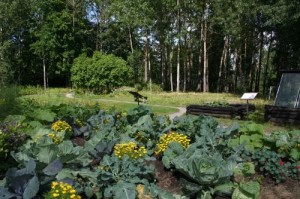










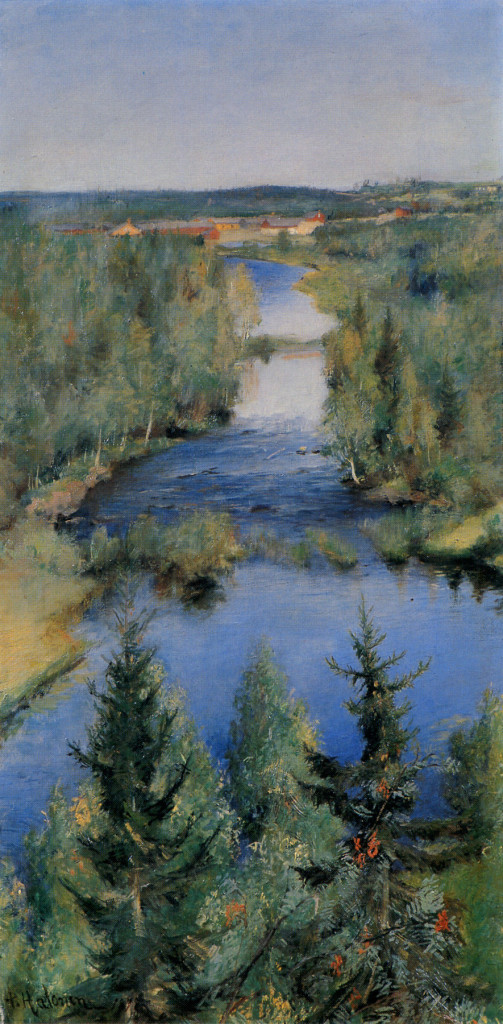

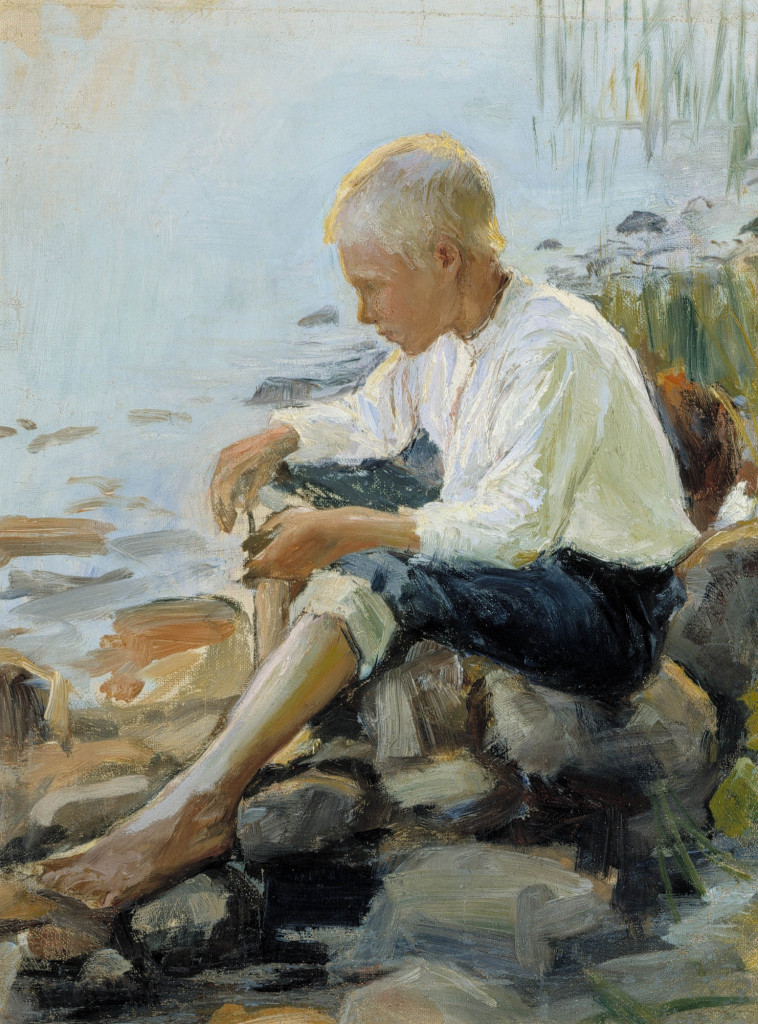













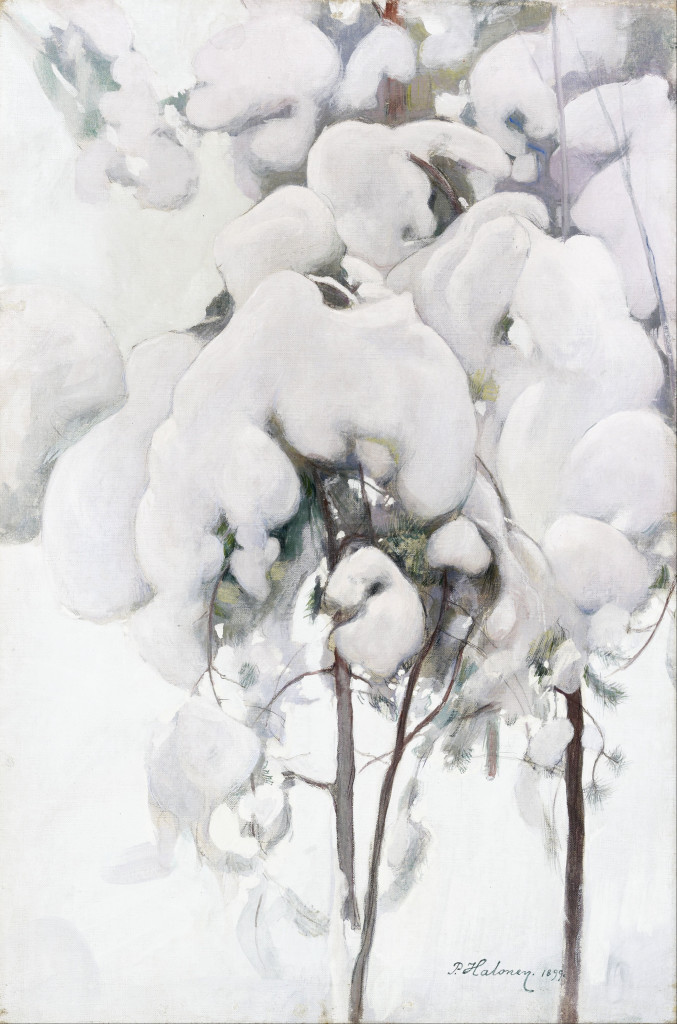












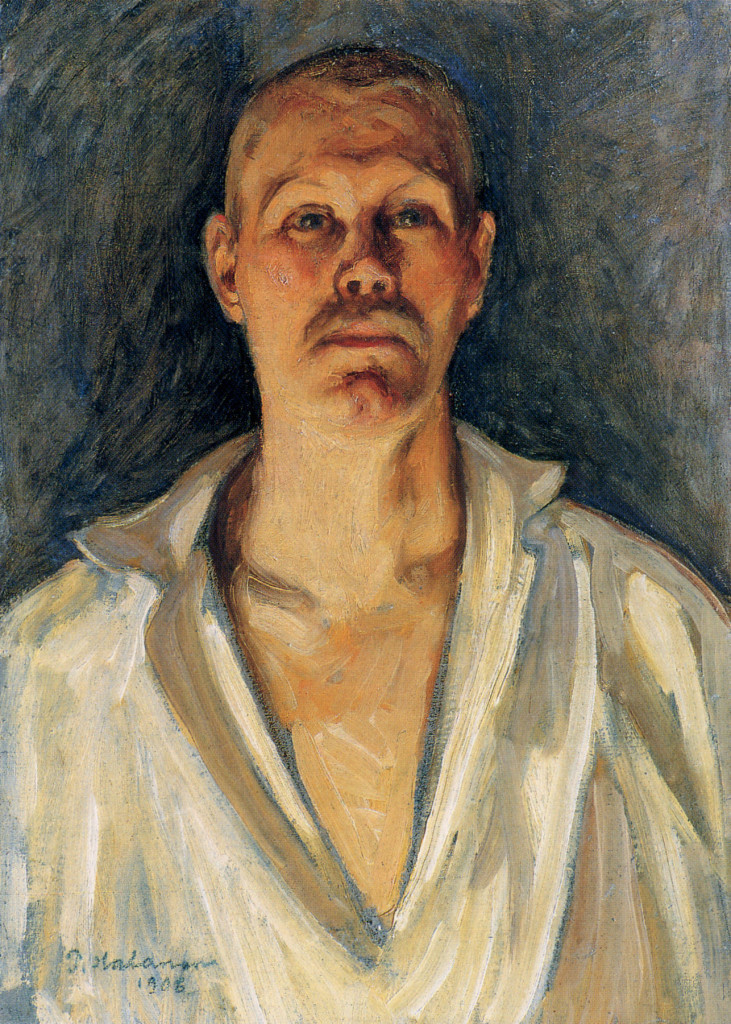





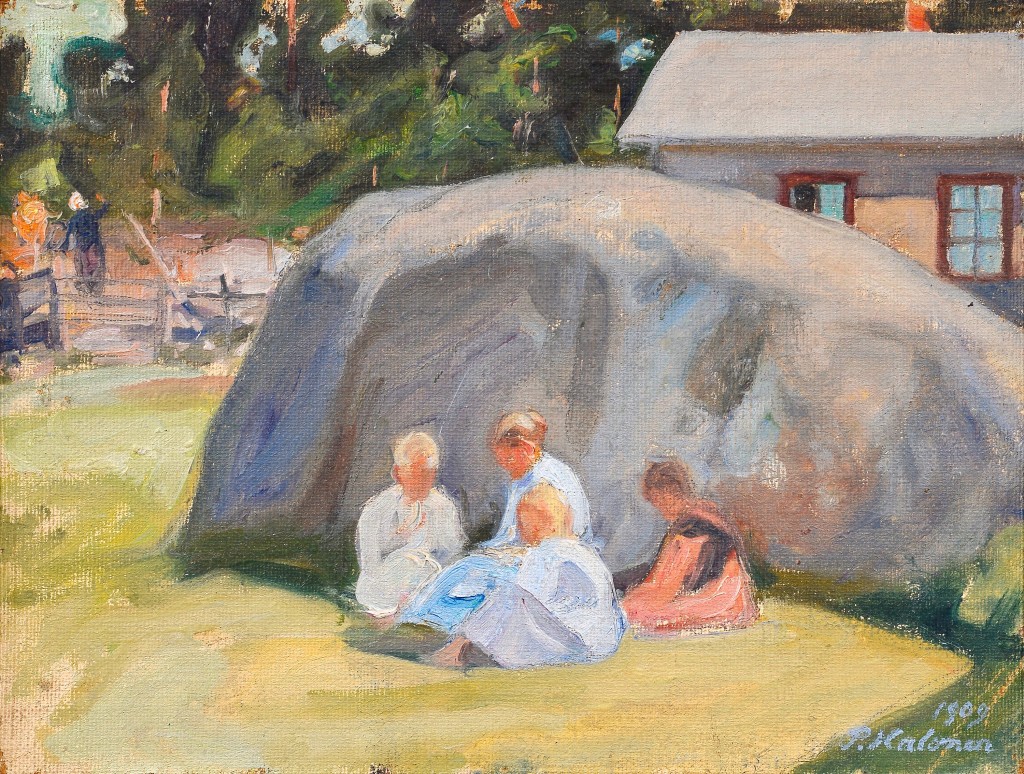





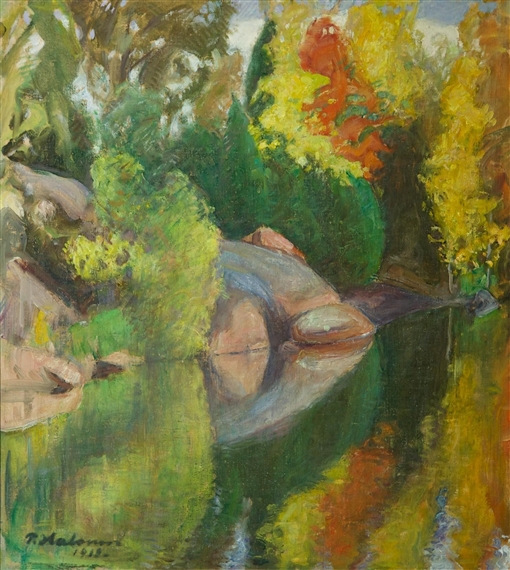



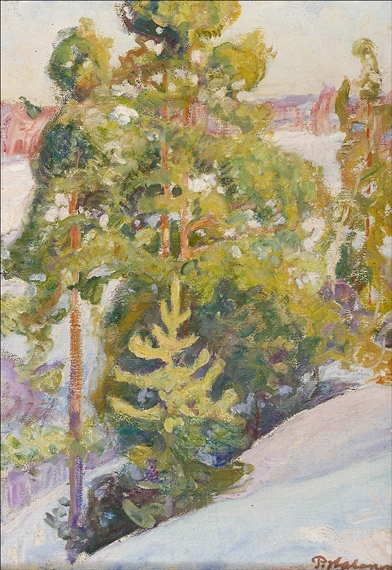
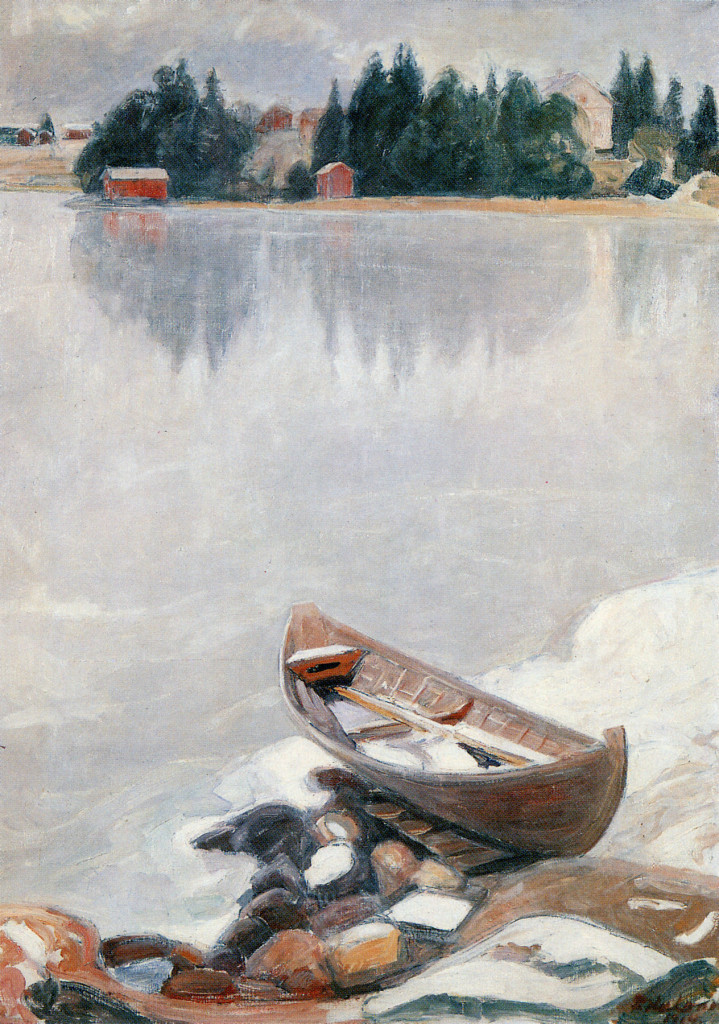







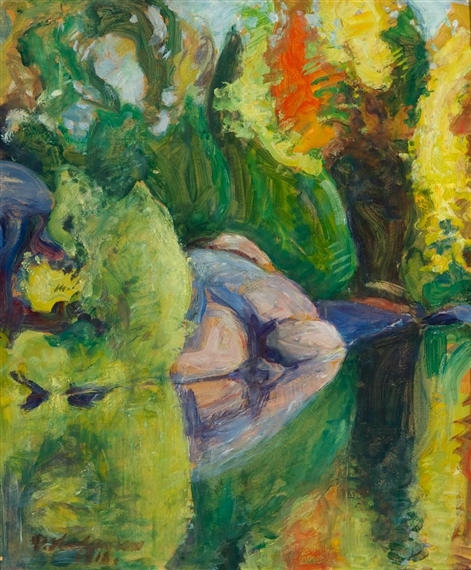




















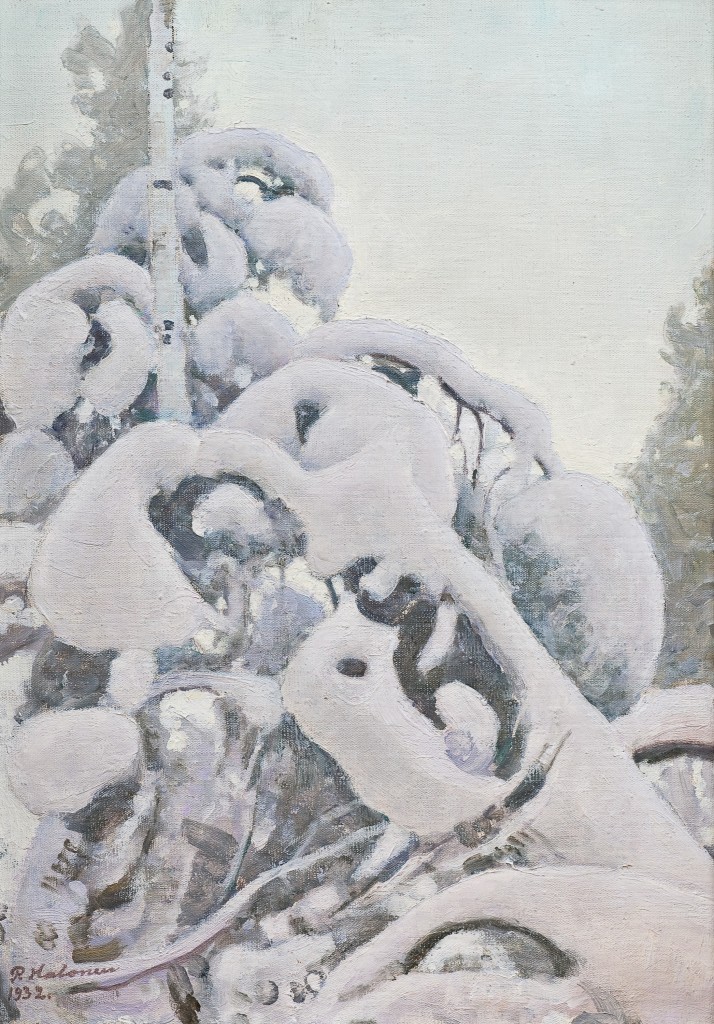



2 Responses to The Life and Art of Pekka Halonen